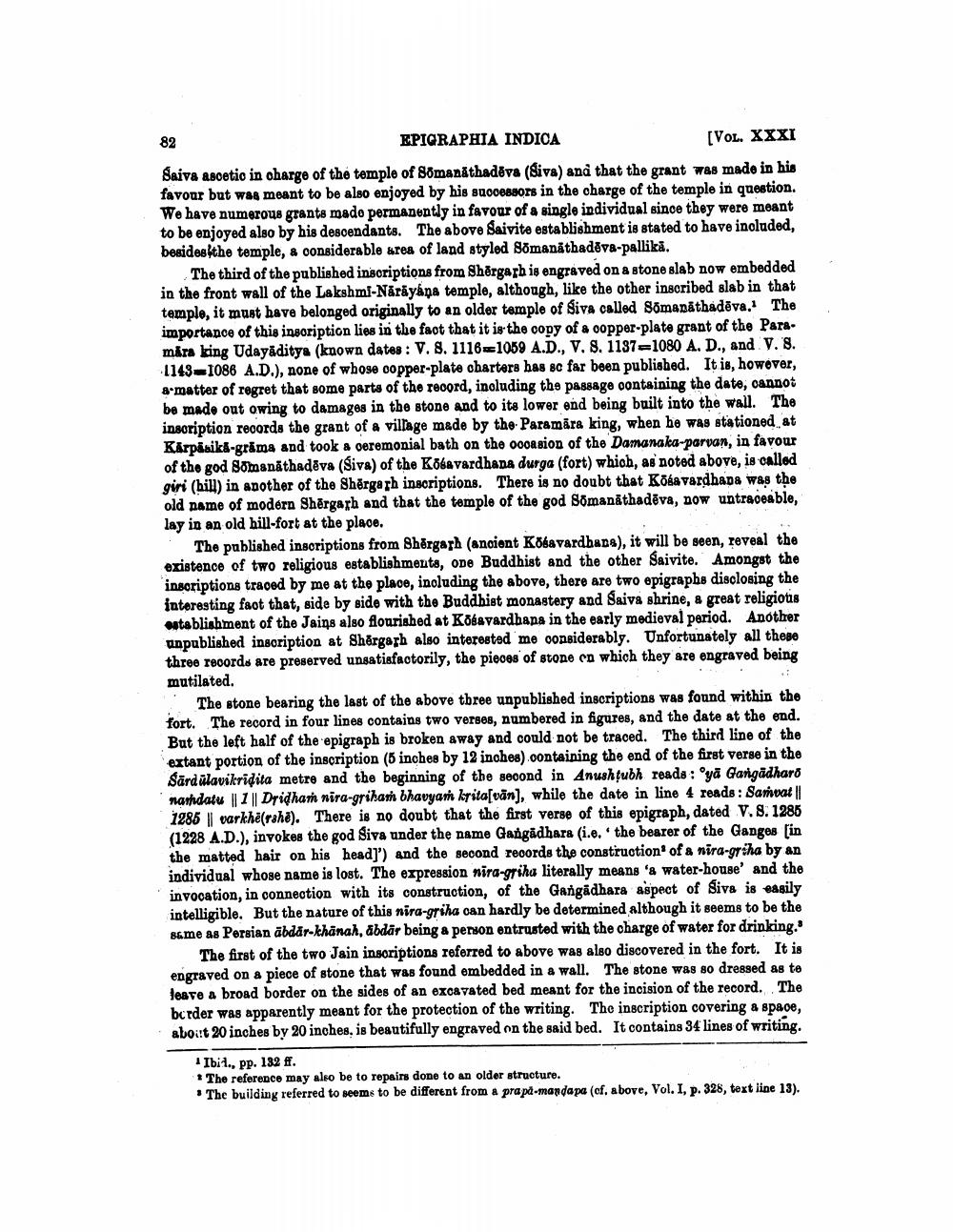________________
EPIGRAPHIA INDICA
[VOL. XXXI
Saiva ascetio in charge of the temple of 88manāthadēva (Siva) and that the grant was made in his favour but was meant to be also enjoyed by his 9900e8sors in the charge of the temple in question. We have numerous grants mado permanently in favour of a single individual since they were meant to be enjoyed also by his descendants. The above Saivite establishment is stated to have included, besides the temple, & considerable area of land styled Somanäthadova-pallika.
The third of the published inscriptions from Shērgarh is engraved on & stone slab now embedded in the front wall of the Lakshmi-Näräyána temple, although, like the other inscribed slab in that temple, it must have belonged originally to an older temple of Siva called Sömanāthadēva. The importance of this insoription lies in the fact that it is the copy of a copper-plate grant of the Paramira king Udayāditya (known dates: V. 8. 1116=1059 A.D., V. 8. 1137=1080 A. D., and V. 8. 1143-1086 A.D.), none of whose copper-plate charters has so far been published. It is, however, a-matter of regret that some parts of the reoord, inoluding the passage oontaining the date, cannot be made out owing to damages in the stone and to its lower end being built into the wall. The inscription records the grant of a village made by the Paramära king, when he was stationed at Kárpásika-grims and took a ceremonial bath on the occasion of the Damanaka-parvan, in favour of the god somanäthadeva (Siva) of the Kobavardhana durga (fort) which, as noted above, is called giri (bill) in another of the Shērgarh inscriptions. There is no doubt that Kolavardhana was the old name of modern Shērgarh and that the temple of the god 88manāthadēva, now untraceable, lay in an old hill-fort at the place.
The published inscriptions from Shargarh (ancient Kobavardbune), it will be seen, reveal the existence of two religious establishments, ode Buddhist and the other Saivite. Amongst the inscriptions traced by me at the place, inoluding the above, there are two epigraphs disclosing the interesting fact that, side by side with the Buddhist monastery and Saiva shrine, & great religious astablishment of the Jains also flourished at Kobavardhana in the early medieval period. Another unpublished inscription at Shargarh also interested me considerably. Unfortunately all these three records are preserved unsatisfactorily, the pieces of stone on which they are engraved being mutilated.
The stone bearing the last of the above three unpublished inscriptions was found within the fort. The record in four lines contains two verses, numbered in figures, and the date at the end. But the left half of the epigraph is broken away and could not be traced. The third line of the extant portion of the inscription (5 inches by 12 inches) containing the end of the first verse in the Sārdülavikridita metre and the beginning of the second in Anushțubh reads : 'ya Gangadharo nashdatu || 1 || Dridan nira-griham bhavyan krita[vān), while the date in line 4 reads : Samvat || 1285 || varkhë(rahë). There is no doubt that the first verse of this epigraph, dated V.8. 1285 (1228 A.D.), invokes the god Siva under the name Gangadhara (i.e. the bearer of the Ganges [in the matted hair on his head]") and the second records the construction of & nira-griha by an individual whose name is lost. The expression nira-griha literally means '& water-house and the invocation, in connection with its construction, of the Gangadhara aspect of Siva is easily intelligible. But the nature of this nira-griha oan hardly be determined although it seems to be the same as Persian ābdar-khanah, abdär being a person entrusted with the charge of water for drinking."
The first of the two Jain insoriptions referred to above was also discovered in the fort. It is engraved on a piece of stone that was found embedded in a wall. The stone was so dressed as te leave a broad border on the sides of an excavated bed meant for the incision of the record. The border was apparently meant for the protection of the writing. The inscription covering & space, about 20 inches by 20 inches, is beautifully engraved on the said bed. It contains 34 lines of writing.
Ibid., pp. 132 ff. * The reference may also be to repairs done to an older structure. • The building referred to seems to be different from a prapa-mandapa (of, above, Vol. I, p. 328, text line 13).




